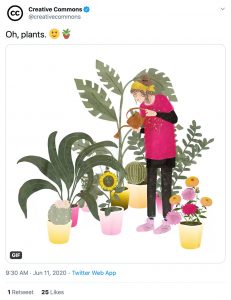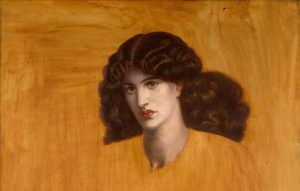Help us protect the commons. Make a tax deductible gift to fund our work. Donate today!
The following is a summary of “GLAM Collections on Social Media: Navigating Copyright Questions—a conversation with Aleksandra Strzelichowska, Mikka Gee Conway and Anne Young” published on 31 May 2020 by Scann (licensed CC BY).
How often do you debate whether to share an openly licensed work on social media? If you do share a work, how often do you fret over whether you’ve provided proper attribution? I’ll answer first: All the time!
Sharing openly licensed works (e.g. images, GIFs, videos, etc.) on social platforms can feel like a fraught space to venture into—and as we’ve learned over the last few years, this is especially true for GLAM (galleries, libraries, archives, and museums). To answer some of the recurring questions these institutions have about sharing openly licensed works on their social media platforms, including works from their own collections, the copyright community at Europeana, Open GLAM, and the Special Interest Group on Intellectual Property at the Museum Computer Network organized a digital panel featuring Aleksandra Strzelichowska (Senior Online Marketing Specialist at Europeana Foundation), Mikka Gee Conway (Associate General Counsel of the J. Paul Getty Trust), and Anne Young (Director of Legal Affairs and Intellectual Property at Newfields) on 30 April 2020.
In this post, I briefly summarize a few notes from this discussion to help inform your decisions on what and how to share on social media.
Copyright policies and guidance for sharing on social media accounts
Europeana follows a four-page document that includes clear guidelines for sharing content online. Essentially, the organization only shares media that is deemed “freely re-usable,” which means it’s in the public domain (e.g. through CC0) or licensed CC BY or CC BY-SA. If a piece of content has a “no reuse statement” then Europeana will seek individual permissions from the copyright holder—but that’s a rare occurrence. The Getty Museum’s general policy is to only share copyrighted content if Getty holds the copyright license or if it can make a strong “fair use” case. Otherwise, Getty tends to focus on sharing material found in the public domain. Finally, Newfields follows a similar policy as Getty. In particular, it focuses on seeking permission for reusing works from donors, affiliated artists, and/or estates.
Policies in practice: Attribution on social media

An example from Creative Commons on giving attribution for a GIF with a CC BY-NC-ND license on Twitter. See the full example here.
Due to the nature of social media platforms, including the limited character counts, it can be difficult to provide detailed attribution for shared media. However, it’s important to make a concerted effort, particularly if the content being shared is done so under a “fair use” claim. On Twitter, for example, the best practice is to utilize the “reply” function to provide detailed attribution when necessary. On Instagram, it’s more difficult to provide proper attribution since there is no linking function in the description of posts, therefore it may be best to stick with content that is in the public domain or that the organization holds the copyrights to. To overcome this issue, Europeana created a landing page that is linked to in its biography description on Instagram. This page houses all of the images the organization posts on its Instagram account, providing source and attribution information.
For editorial pieces, like blog posts, that are housed on a website and then shared through social media, it’s important to provide attribution for openly licensed works in the body of that post. For example, the caption of an image can contain the attribution information and/or it can be added to the image’s metadata. If the image is in the public domain, it’s best practice to also identify provenance—where the work is stewarded—this includes listing the GLAM the image was sourced from. For more guidance, check out this page.
CC licenses and terms of service: What about NC-licensed content?
This can be a sticky issue for GLAM institutions, complicated by the terms of service for each individual social media platform. Some assume that if a social media platform’s terms require or indicate that a user gives the platform the license to use their content for commercial purposes (like marketing) then the spirit of the NonCommercial (NC) license is violated. Thus, the conservative approach is to avoid posting NC-licensed content.
However, there is some basis for thinking otherwise. CC Legal Counsel Sarah Pearson explained that CC licenses don’t allow sub-licensing so uploaders are not granting the platform any rights directly to content that isn’t theirs under copyright. Most social media terms of service require that a user either a) owns the copyright to their posted content or b) has the right to use that content. When that’s the case, openly licensed content is appropriate to share on the social media platform as long as the license requirements are followed by the uploader. As for NC-licensed content specifically, so long as the uploader is sharing the content for noncommercial purposes, the NC restriction is likely more of an issue for the platform, if at all, to the extent the platform must rely on the NC license.
The important role of digital asset management systems
Many organizations, especially GLAM institutions, have digital asset management systems (DAMS) that contain object metadata, including rights information, that everyone within the organization has access to. At Getty, for example, the DAMS is directly supported by a Rights and Reproduction team member that is responsible for entering objects into the system and ensuring the rights information for each object is included. Their system also includes separate folders that specify what an object can be used for, whether it’s for a blog post or a social media post. In some cases, objects are approved for use on the website or for distribution by the media but not for social media platforms, so the DAMS is crucial for ensuring those objects are not used improperly.
Newfields, which also has a DAMS, and Getty offer training to team members on how to use the system since the metadata can be complicated to read and interpret. This is particularly true when non-copyright issues come up for a particular object, such as privacy and/or publicity considerations. Since Europeana aggregates data, its process is more straightforward. Put simply, if the object is on the website then it should be OK to use for any purpose by the marketing and communications team.
Guidelines and strategies on how users can reuse shared content

Image credit: La Donna Della Finestra, 1881 by Dante Gabriel Rossetti via Birmingham Museums Trust (CC0). The featured version of this image has icons by Samsul Rizzai, Austin Condiff, Maxim Kulikov, and Kendedes licensed CC BY via the Noun Project.
Europeana has been educating users on reusing its content through engagement initiatives. For example, during the annual GIF IT UP! contest, it routinely educates people on open licensing and attribution requirements. If someone submits a GIF based on a work that is not openly licensed, they receive an email explaining why their submission wasn’t accepted and are given instructions on what they can do to rectify the situation. At Getty, following the launch of its open content program in 2013, the organization published a clear set of terms of use and provided additional educational resources on its website. Today, it’s looking at dedicating many of its open content to the public domain using CC0 so that there’s less confusion for users.
Open access in the age of COVID-19
The panelists agreed that due to the COVID-19 pandemic, a conversation around copyright has emerged that feels especially urgent as it’s tied to this moment—specifically regarding what GLAMs should and shouldn’t do. In some cases, boundaries are definitely being pushed. However, the panelists urged institutions to take a more cautious and measured approach when embarking on new digital projects and initiatives. “I definitely feel that it’s important to be measured about all this, and think about what it is exactly about our changed situation that might merit pushing boundaries of copyright?,” Mikka argued. “That is absolutely true,” Anne replied, “…at the end of the day, while there might be pushing some boundaries we still need to proceed cautiously because the laws [themselves] haven’t changed.”
P.s. I highly recommend reading the full conversation for more insights and examples from Europeana, Getty, and Newfields—and bookmarking it for future reference!
Our friends over at Open GLAM want to hear from you! How do you attribute openly licensed works on social media? What challenges are you facing in this area? What training or education are you looking for? Let them know by sending an email, tweeting at OpenGlam, or joining their monthly calls!
Posted 15 June 2020